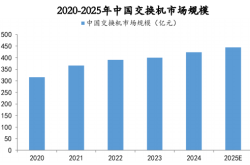【Lenovo】Joins "VK Cup·OFweek 2025 (10th) Annual AI Industry Awards"
![]() 06/06 2025
06/06 2025
![]() 535
535
The VK Cup·OFweek 2025 (10th) Annual AI Industry Awards, also known as OFweek 10th AI Awards 2025, is hosted by China's leading high-tech industry portal, OFweek, and organized by OFweek AI. This prestigious event stands as a cornerstone brand event within the AI industry, renowned for its professionalism and influence across the high-tech sector.
The aim of this event is to establish a robust platform for brand communication and showcasing products, technologies, and enterprises within the AI industry. Leveraging OFweek's extensive platform resources and influence, it introduces innovative products and solutions to industry users and the broader market, fostering a culture of technological innovation among enterprises. Simultaneously, it strives to deliver cutting-edge technologies and innovative products to the industry, collectively envisioning the future of AI.
The registration deadline for this prestigious award ceremony is June 13, with the online voting phase scheduled from June 18 to June 27, 2025. A grand award ceremony will take place in Shenzhen on July 30. Currently, the event is witnessing an overwhelming response from industry enterprises, as it enters a heated phase of enterprise applications.
Participating Enterprises
As a global leader in ICT technology, Lenovo embodies the philosophy of "Intelligence for Every Possibility." The company relentlessly pursues research, design, and manufacturing of the most comprehensive portfolio of end-to-end smart devices and smart infrastructure products. It offers users and the industry smart terminals that seamlessly integrate applications, services, and optimal experiences, along with robust cloud infrastructure and industry-specific intelligent solutions.

Award Entry Information
Award Category: VK Cup·OFweek 2025 Excellent Innovation Product Award in the AI Industry
Product Name: Lenovo LeOPT Optimization Platform
Product Features:
The Lenovo LeOPT Optimization Platform offers end-to-end full-stack optimization capabilities, encompassing flexible modeling, efficient solving, and analysis. It effectively addresses resource allocation and task planning challenges across multiple industries, including supply chain, transportation, and finance. Drawing on Lenovo Group's best practices, the platform boasts a ready-to-use mature optimization model repository, empowering users to tackle optimization challenges in various scenarios efficiently.
Furthermore, the Lenovo LeOPT Optimization Platform features multiple built-in basic models, supporting auxiliary modeling methods such as interactive and agent-based modeling. This enhances users' ability to address optimization challenges in complex scenarios.
1. Natural Language Modeling Enhances Modeling Efficiency
Innovatively integrating large language model-based agents (LLM-based agents) with operations research optimization technology, the platform presents a natural language-driven automated modeling solution. Users input natural language scene descriptions, and the platform parses these descriptions, analyzes optimization factors, and gradually generates variables, constraints, and objective functions through interaction. This results in operations research optimization models being built from scratch under user interaction and supervision. Once built, the model is automatically stored in the optimization platform's model repository, allowing users to upload business data and invoke the solver for a solution. The agent also conducts in-depth analysis of the results post-solving, providing data insights and realizing a seamless process from demand description to mathematical modeling, code generation, and decision analysis. Compared to traditional modeling tools, the model development cycle is significantly shortened by 70%. Additionally, through domain knowledge enhancement and data-model collaborative verification, the model generation accuracy is improved by 42% compared to general LLM platforms, facilitating data-driven intelligent decision-making upgrades for enterprises.
2. Interactive Modeling Enhances Interpretability
The Lenovo LeOPT Optimization Platform lowers the barriers to traditional modeling. Through interactive modeling, it significantly reduces modeling difficulty, enabling even non-professional business personnel to quickly complete model construction under the platform's guidance. Operations research optimization modeling in the industrial field aims to enhance various business indicators while adhering to complex and diverse business logic rules. This requires simultaneous consideration of numerous decision-making factors. As a result, practical problems often present various modeling challenges, ranging from basic physical laws and scene infrastructure to multi-objective optimization, global optimization, and other industry demands, even including external factors such as dynamic changes and real-time impacts. The platform assists modelers in dissecting and quantifying these modeling elements one by one, converting them into mathematical language. For example, inequality constraints are used to limit resource caps, and structural equations describe variable relationships, which are then organically combined into a complete model system. This process not only sorts constraints in detail but also displays a visualizable and configurable decision path through interactive modeling. This enables users to clearly understand the impact of each model parameter on the results, making "black box models" transparent. This deep human-computer interaction and clear explanation mechanism not only improves decision-making efficiency but also builds a strong trust bridge between users and the platform, fostering a sustainable human-computer collaboration ecosystem.
3. Self-developed Solver Ensures Efficiency and Adaptability
The platform supports diverse modeling approaches, including linear programming, mixed-integer programming, and constraint programming. Whether it's a linear optimization scenario aiming for efficient resource allocation, a complex combinatorial problem involving discrete variable decision-making, or a constraint-solving task requiring handling of multi-dimensional constraints, the platform can flexibly invoke an adaptive solution as needed. In terms of problem-solving, the Lenovo LeOPT Optimization Platform integrates the LeOPT solver, a cutting-edge computing engine developed by the Lenovo Research Institute's AI Lab. It significantly boosts problem-solving speed through innovations such as optimizing the search framework and enhancing hybrid reinforcement learning samples. In complex optimization tasks, transforming a large mathematical model into a solution model can be time-consuming and inefficient. LeOPT employs a specifically designed mapping algorithm for complex constraints, improving model transformation efficiency by over three times compared to traditional methods. Leveraging a phased optimization algorithm with machine learning technology, LeOPT intelligently identifies and automatically tunes parameters based on problem-matched algorithm model techniques, providing deeply customized solution schemes tailored to users' specific problems. This not only vastly improves solving efficiency but also ensures LeOPT's adaptability to diverse industry problems.
Reasons for Participation:
In today's interconnected world of data and decision-making, minor decision errors can trigger significant chain reactions. For instance, in the financial industry, a 1% deviation in asset allocation due to a model error when an asset management company optimizes its investment portfolio could result in direct losses of millions or even tens of millions of yuan. Similarly, decision errors in production line scheduling in manufacturing can lead to idle equipment and affect order delivery. Optimization has become a crucial survival rule for organizations in the digital Darwinian era. However, optimization modeling and solving are notoriously challenging tasks.
As a core tool for solving complex real-world problems, mathematical modeling has a high application threshold due to its technical depth and knowledge barriers. Given the diversity and uniqueness of actual scenarios, different fields need to construct highly adaptable and differentiated model systems. In supply chain optimization scenarios, material procurement plans typically rely on linear programming technology for precise resource allocation, while master production schedules necessitate mixed-integer programming or reinforcement learning algorithms for dynamic optimization of production scheduling. When facing complex production scheduling, a combination of mixed-integer programming, constraint programming, and heuristic optimization methods is often required to achieve a global optimal solution. Moreover, real-world problems often exhibit multi-dimensional and complex characteristics. Taking logistics optimization as an example, its business processes encompass three core links: loading, routing planning, and wiring unloading. Each link corresponds to specific mathematical problems: The loading link involves the 3D bin packing problem, aiming to maximize loading efficiency under spatial constraints; the routing planning link addresses the complex problem of multi-route planning for the same journey with loaded goods, requiring consideration of timeliness, cost, and dynamic adjustment of road conditions; the wiring unloading link corresponds to the flexible job shop scheduling problem, necessitating overall planning of platform utilization, unloading sequence, and order priority. This deep integration of professional knowledge and algorithmic capabilities creates a high technical threshold in the field of mathematical modeling, usually requiring professionals with profound mathematical foundations and rich algorithmic experience to tackle these complex and challenging real-world problems.
Furthermore, the construction of optimization models necessitates a profound understanding of business needs. Different industries and regions have vastly different requirements. Taking the retail industry as an example, the inventory optimization model for online and offline integration must fully consider factors such as product seasonality, promotional activities, and consumer purchasing habits. Only by accurately grasping business logic can a model that meets actual needs be constructed.
In terms of problem-solving, many practical problems involve a vast number of variables and constraints, such as in large-scale production scheduling scenarios. These encompass continuous variables like production time and cost, discrete variables like task assignment and equipment selection, and numerous constraints such as production capacity limits, material ratios, order delivery methods, and dates. Solving such large-scale models results in exponentially increasing computational complexity, demanding significant computational resources and time. Different types of models require distinct solving algorithms, but finding a universal algorithm that can efficiently solve all models is challenging. To address complex model solving, heuristic algorithms or simplified scenario models are often chosen. While heuristic algorithms can find approximate optimal solutions in a relatively short time, they cannot guarantee a global optimal solution, and their performance may vary greatly for different problem instances, introducing a degree of uncertainty. Simplifying and assuming practical problems may deviate from actual conditions, leading to suboptimal solutions in practical applications.
Given the current industry challenges of high thresholds for mathematical modeling and difficulties in solving complex real-world scenarios, the Lenovo LeOPT Optimization Platform provides users with efficient solutions through its comprehensive technical capabilities and innovative functions. The specific advantages are as follows:
Ready-to-use Mature Models: Leveraging Lenovo Group's extensive practical experience across multiple fields, the LeOPT Optimization Platform boasts a mature optimization model repository. Users do not need to build models from scratch but can directly utilize the model resources in the repository, quickly responding to various optimization challenges and significantly saving modeling time and labor costs.
Intelligent Guidance for Interactive Modeling: For users with autonomous modeling needs, the platform's interactive modeling function offers robust support. With a rich built-in basic model library and intelligent selection logic, the platform can recommend suitable modeling paths for users based on problem type, scale, and variable characteristics. This not only reduces the complexity of modeling operations but also enhances model interpretability, gradually fostering a long-term and stable human-computer collaboration trust relationship between users and the platform.
Efficient and Accurate Natural Language Modeling: Faced with specific scenario requirements, the platform's natural language modeling capabilities excel. Compared to traditional modeling tools, using natural language modeling can reduce modeling time by 70%, significantly improving modeling efficiency. Additionally, through domain knowledge enhancement and data-model collaborative verification mechanisms, the model generation accuracy is improved by 42% compared to general large language platform models, ensuring that the model quality aligns closely with actual needs.
Multiple Modeling Techniques: Embedded with various modeling techniques such as mixed-integer programming and constraint programming, users can flexibly select suitable technical solutions based on the characteristics and needs of different scenarios, enabling customized modeling and ensuring optimization effects. In high-value scenarios, the platform introduces unique advanced modeling methods, leveraging cutting-edge technologies like deep reinforcement learning, nested optimization, and model decomposition, to effectively solve optimization challenges in large-scale scheduling and complex scenarios.
Equipped with our state-of-the-art self-developed LeOPT solver, which is ranked among the top globally, our platform excels in solving comprehensive optimization challenges, including linear programming (LP), mixed-integer programming (MILP), and quadratic programming. It particularly shines in addressing large-scale, complex combinatorial optimization problems. Through the innovative integration of machine learning with traditional optimization algorithms, it offers intelligent parameter tuning and automatic model preprocessing, efficiently managing industrial-scale issues with millions of variables.
The Lenovo LeOPT Optimization Platform has made significant impacts across various manufacturing sectors, such as consumer electronics, specialized equipment, automobiles, and shipbuilding. It covers diverse scenarios like master planning, material requirements planning, factory planning, detailed workshop scheduling, inventory optimization, and logistics optimization. For instance, in enhancing the off-site logistics plan of a joint venture automotive enterprise, the platform increased the average loading rate to over 86% and the leveling rate of wiring time to 91.2%. When assisting a large shipbuilding company in optimizing its overall assembly and loading schedule, it reduced the docking period optimization time to within 15 minutes, boosted the assembly platform utilization rate to over 62%, and shortened the docking construction time to within 75 days.
Join Us Now
The "OFweek 10th AI Awards 2025" is currently in the exciting phase of enterprise applications, with a deadline of June 13th.
This is a prime opportunity for companies to showcase their strengths and gain industry recognition. Don't miss out! Interested enterprises can click "Read the Original" at the bottom of this text or visit the link below to take immediate action and let your business shine in the realm of AI!
Quick Access for Enterprise Application Evaluation:
https://forms.ofweek.com/Form/preview/form_id/2019








